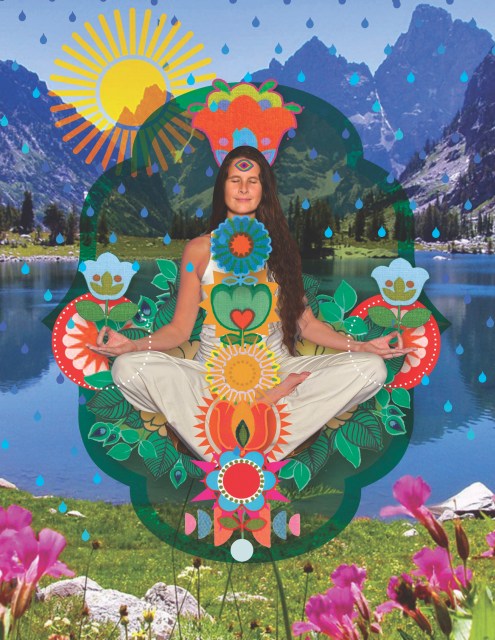Kundalini is often translated as “coiled up” or “coiled one” and is depicted visually as a coiled up snake. It is a form of energy or consciousness that is said to reside at the base of the spine. This consciousness lies dormant or unexpressed until awakened. Yoga practices, such as asana (postures), pranayama (breath exercises), meditation, and more, assist with awakening kundalini energy.
While it is possible that a kundalini awakening may be an experience of feeling an electric current or electricity-like sensations in your body or rainbow fireworks shooting along your spine with a feeling of illumination around the crown of your head, these are not the only ways to experience this type of energy.
I believe that yoga is a “practical practice” of increasing awareness or rather remembering and becoming aware of what we already know. It is designed to awaken what was once a dormant or unexpressed consciousness (kundalini). Once we connect to that consciousness, we increase our awareness and may break the cycles of “same suffering” (samsara) to attain a liberated state of equanimity. Ultimately, yoga is about seeing all with an equal eye, which results in unconditional love for your self and for others. We achieve this goal by practicing kindness in every thought, word, and action, every minute of every day.
Kundalini energy sits dormant until it is awakened through self-care/self-love practices and service to others. When awakened, kundalini energy moves through the chakras, or energy centers of the subtle body. Each chakra relates to different functions (such as survival, intimacy, self-worth, compassion, communication, and inner wisdom) and relationships (such as parents, romantic partners, those we have hurt and those that have hurt us, and one’s self). When kundalini is awakened in these areas we have the opportunity to function at a clearer level and purify our relationships. While “awakening kundalini” may sound like a fancy or mysterious practice, it’s quite simply about being kind, gentle, and loving to ourselves and to fellow beings.
Kundalini awakening is not unique to the practices of yoga. Anyone may experience this type of awakening. One example that I view as a kundalini awakening is the story of Ann Wigmore. When Ann was diagnosed with cancer, she had the choice to accept doctors telling her that there was not anything that might change her condition and her soon death or to take her life into her own hands and seek alternative healing. Ann chose to take her life into her own hands. (You might think of this as kundalini movement to Ann’s manipura chakra or self-worth/will power energy center and ajna chakra or intuition energy center.) Through personal research and following her intuition, she healed herself from cancer. This is an example of consciousness awakened within.
Early on in my practice of yoga, where my focus was primarily asana, I noticed that certain foods started to fall away from my diet—food that ultimately did not serve in maintaining the enhanced way of being that I felt through practice of the various poses and deep relaxation. This for me was an experience of my kundalini rising or, in other words, my awareness increasing.
Another example of kundalini awakening is a shift out of the “poor me” mentality or blaming others to taking responsibility for our actions. My son Noah may leave his toys on the hallway floor and I may step on one and hurt my foot. When my response is one of, oh, this is a reminder for me to pay more attention to my surroundings and be more mindful, verses getting upset that I hurt my foot and blaming Noah for leaving his toys on the floor, this is consciousness. Yes, kundalini rises in everyday moments.
When I say that I can’t afford this trip, this workshop, this food, this fill in the blank, because of x-y-z (the blame game) and instead I say, I create my reality and this is not in my budget at this time, though I imagine it will be in the future—or I’m going to find a way to fit this into my budget, this is an awakening of consciousness. This is kundalini rising.
When we choose to be calm and peaceful over being frustrated and upset…when we choose to be kind and gentle in a world of horrific violence…when we choose to take responsibility for our actions over blaming others (act/respond verses react), this is an awakening of consciousness. This is kundalini rising.
Don’t feel lost among “fancy” words. Find your way back to the simplicity of loving yourself and others. Do the inner work of self-care and service to fellow beings and the earth and you’ll experience kundalini awakening.
Background of kundalini and practices that awaken this energy may be found in texts, such as the Hatha Yoga Pradipika and Yoga-Kundalini Upanishad, also called Yogakundali Upanishad. You may also like to check out Chapter 7 of my book on “The Subtle Body Made Simple.”
Anna Ferguson is the author of World Peace Yoga: Yoga for People Who Breathe, a book on yoga that inspires peace in action, developing intuition, deepening empathy, and expanding compassion. You may connect with Anna via Instagram @annafergusonpeace or via Facebook

